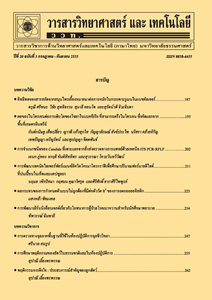การจัดการทางโภชนาการสำหรับการเลี้ยงปลานิล
Main Article Content
Abstract
บทคัดย่อ
ปลานิลมีราคาจำหน่ายไม่สูงเนื่องจากเป็นปลาที่เลี้ยงกันอย่างแพร่หลาย ดังนั้นการลดต้นทุนการผลิตโดยเฉพาะค่าอาหารเป็นวิธีการหนึ่งที่สามารถเพิ่มผลตอบแทนให้แก่เกษตรกรได้ การลดต้นทุนค่าอาหารอย่างมีประสิทธิภาพนั้นจำเป็นต้องมีการจัดการเกี่ยวกับสารอาหารและวิธีการให้อาหารที่เหมาะสม โดยอาหารปลานิลควรมีระดับโปรตีน 25-45 % ไขมัน 5-12 % คาร์โบไฮเดรต 20-50 % ใยอาหาร ≤6 % กรดไขมันกลุ่ม n-6 และ n-3 0.5-1.0 % แคลเซียม 0.3 % และฟอสฟอรัส 0.7 % นอกจากสารอาหารแล้ววิธีการให้อาหารมีความสำคัญเช่นเดียวกัน โดยควรให้อาหารปลานิลวัยรุ่นอย่างน้อย 2 ครั้งต่อวัน และแต่ละมื้อมีระยะห่างประมาณ 4-5 ชั่วโมง การลดต้นทุนวัตถุดิบอาหารของทั้งโรงงานผลิตอาหารและเกษตรกรที่ผลิตอาหารใช้เอง อาจทำได้โดยการแทนที่ปลาป่นด้วยเนื้อและกระดูกป่น ไก่ป่นหรือโปรตีนข้าวโพด และแทนที่น้ำมันปลาทะเลด้วยน้ำมันชนิดอื่นได้ แต่ปริมาณกรดไขมันกลุ่ม n-6 และ n-3 ในอาหารต้องไม่ต่ำกว่าระดับที่ปลานิลต้องการ การลดต้นทุนค่าอาหารอาจทำได้โดยการเพิ่มการใช้ประโยชน์อาหารเพื่อเร่งการเจริญเติบโต เช่น การเสริมอาหารด้วยวิตามินซี Schizochytrium sp. ยีสต์ Saccharomyces cerevisiae เอนไซม์ย่อยอาหารหรือเบต้ากลูแคน รวมทั้งการเพิ่มปริมาณแพลงก์ตอนพืชในระบบเลี้ยงสามารถเร่งการเจริญเติบโตของปลาและประหยัดค่าอาหารได้
คำสำคัญ : ปลานิล; โภชนาการ; ความต้องการสารอาหาร; การให้อาหาร
Abstract
Nile tilapia (Oreochromis niloticus) has low farm gate price because there has been widely cultured. Therefore, reducing production cost particularly feed cost is one of methods which can increase fish farmer benefit. Efficient reducing feed cost requires appropriate managements of both nutrient and feeding method. The diet should contain the required nutrients, namely protein (25-45 %), lipid (5-12 %), carbohydrate (20-50 %), fiber (≤6 %), total n-6 and n-3 fatty acids (0.5-1.0 %), calcium (0.3 %) and phosphorus (0.7 %). In addition to nutrients, feeding method is also critical, for example feeding juvenile fish at least twice a day with an interval time of 4-5 hours should be practiced. Reducing feedstuff costs of both feed mill and home-made feed famer may be done by replacing dietary fishmeal with meat and bone meal, poultry meal or corn gluten. Also, marine fish oil can be replaced by another oil, but dietary n-6 and n-3 fatty acids should not lower than the requirements. Reducing feed cost may be done by increasing feed utilization to accelerate fish growth such as dietary supplementation of vitamin C, Schizochytrium sp., yeast Saccharomyces cerevisiae, digestive enzyme or β-glucan. Also, increasing phytoplankton in the culture system can accelerate fish growth and indirectly saves feed cost.
Keywords: Nile tilapia; nutrition; nutrient requirement; feeding


